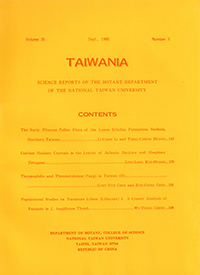Research Paper
Calcium Oxalate Crystals in the Leaves of Nelumbo Nucifera and Nymphaea Tetragona
Ling-Long Kuo-Huang
Published on: September 1990
Page: 178 - 190
DOI: 10.6165/tai.1990.35.178
Abstract
Both Nelumbo nucifera Gaertn. and Nymphaea tetragona Georgi contain crystals in their leaves, but the crystals differ in shape, size and distribution. In Nelumbo the crystals, with a druses form, occur in the central vacuole of crystal idioblast. Generally there is only a single druse per cell. As the crystal idioblasts mature, the cell wall partly collapses around the crystal and the sharp points or facets of the crystal protrude into the adjacent air space. In Nymphaea, the crystal has a prismatic form. It was observed in the extraplasmic space between the primary and secondary cell wall of the sclereids. As the sclereids grow, the sharp facets of the crystal become protruded but remain covered by primary wall material. The crystal idioblasts in these two aquatic plants are found associated with aerenchyma. Their formation is suggested to linked with evaporation of water. The crystals in both Nelumbo and Nymphaea were identified as calcium oxalate by means of X-ray microanalysis and acid-etching tests.
中文摘要
荷與睡蓮的葉部均含有結晶體,但其形狀、大小、與分布均各有不同。荷葉中的結晶體呈晶簇狀,存在於結晶異形細胞的中央液泡內。一般而言,宜細胞中只含有一晶簇狀晶體。當結晶異形細胞成熟時,其係包庇局部瓦解,而晶體的尖銳面凸出於細胞空隙間。睡蓮中的結晶體呈角柱狀,存在於厚壁細胞之初生細胞壁與次生細胞壁之間,當厚壁細胞成熟時,其尖銳面突起仍覆蓋著初生細胞壁。此兩種水生植物的結晶異型細胞的位置均伴隨在通氣組織,因此結晶的形成可能與水分的蒸發有關。經由X光微量元素分析術及酸蝕測試,此兩種結晶體的成分為草酸鈣。


